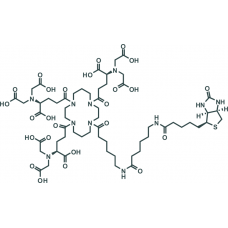Tris-NTA Biotin
- Biotechrabbit
- BR1001201
- Na skladě
- 9 360,00Kč
-
9 180,00Kč
Dostupné možnosti
Dopravné a balné
Transportní
podmínky
cena se připočítává k položkám v objednávce
chlazené
(CoolPacks) 450 Kč bez DPH na zásilky v celkové ceně do 20 000 Kč bez DPH, nad tuto hodnotu je
dopravné a balné zdarma
Features
- A complex of three NTA groups ensures high-affinity binding of His-tags
- Binding affinity is approximately four orders of magnitude higher than monovalent metal ion chelators
- Protein binding is stochiometric
- Tris-NTA is available as amino-group or biotin conjugates
Applications
- Reversible labeling of proteins or cell surfaces
- Detection and analysis of target molecules
- Immobilization of proteins, lipids and cells on surfaces
- Purification and sample preparation of proteins
- Coupling with microscopic or spectroscopic probes (e.g., fluorophores)
Catalog #
Size
Package Content
BR1001201
100 µg
100 µl Tris-NTA Biotin
BR1001202
1 mg
1 ml Tris-NTA Biotin
BR1001203
1 mg
1 mg Tris-NTA Biotin (powder)
biotechrabbit™ Tris-NTA Biotin for high-affinity His-tag binding.
His-tags are one of the most commonly used tags for protein expression analysis. Conventional metal ion chelators, such as nitrilotriacetic acid (NTA) and iminodiacetic acid (IDA), bind His-tags with low affinities in the range of 10 µM. The biotechrabbit Tris-NTA complexes three NTA groups that together bind a 6xHis-tag with an affinity that is four orders of magnitude higher (1 nM) than is possible with conventional chelators. The binding of His-tags is stoichiometric, and single-molecule detection is possible. Binding is reversible: bound His-tags can be released with imidazole or ethylenediaminetetraacetic acid (EDTA).
biotechrabbit Tris-NTA is available in amino-group-conjugated and biotinylated forms and can be used in a large range of applications, including protein detection and marking, protein, lipid or cell coupling to surfaces, protein purification and reversible protein modification.

